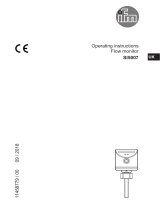
SAxxxx Flow sensor
2
Contents
1 Preliminary note ............................................................. 4
1.1 Symbols used.......................................................... 4
1.2 Warnings used ......................................................... 4
2 Safety instructions............................................................ 5
3 Intended use................................................................ 6
3.1 Application area ........................................................ 6
3.2 Restriction of the application area........................................... 6
4 Function ................................................................... 7
4.1 Output OUT1 selection options............................................. 7
4.2 Output OUT2 selection options............................................. 7
4.3 IO-Link ............................................................... 7
5 Installation.................................................................. 8
5.1 Process connection...................................................... 8
5.2 Interference............................................................ 8
5.3 Installation position...................................................... 9
5.3.1 Immersion depth.................................................... 9
5.3.2 Recommended mounting position....................................... 9
5.3.3 Conditionally possible installation position. . . . . . . . . . . . . . . . . . . . . . . . . . . . . . . . . 9
5.3.4 Impermissible installation position . . . . . . . . . . . . . . . . . . . . . . . . . . . . . . . . . . . . . . . 10
5.3.5 Orientation ........................................................ 10
6 Electrical connection.......................................................... 11
7 Operating and display elements................................................. 12
8 Menu...................................................................... 13
8.1 Menu overview......................................................... 13
8.2 Main menu and submenus ................................................ 13
8.3 Available parameters .................................................... 16
9 Set-up..................................................................... 18
10 Parameter setting............................................................ 19
10.1 Parameter setting via the unit keys . . . . . . . . . . . . . . . . . . . . . . . . . . . . . . . . . . . . . . . . . . 19
10.2 Parameter setting via IO-Link.............................................. 19
10.3 Basic settings.......................................................... 20
10.3.1 Operating mode .................................................... 20
10.3.2 Flow adjustment.................................................... 21
10.3.3 Internal pipe diameter................................................ 23
10.3.4 Standard unit of measurement ......................................... 23
10.3.5 Process value for OUT2 .............................................. 24
10.4 Output configuration..................................................... 24
10.4.1 Switching signal .................................................... 24
10.4.2 Frequency signal.................................................... 26
10.4.3 Analogue signal .................................................... 28
10.5 Application configuration.................................................. 30
10.5.1 Medium........................................................... 30
10.5.2 Output polarity of the switching outputs. . . . . . . . . . . . . . . . . . . . . . . . . . . . . . . . . . . 30
10.5.3 Damping.......................................................... 30
10.5.4 Error behaviour of the outputs.......................................... 31
10.5.5 Switching delay..................................................... 31
10.5.6 Calibration......................................................... 32
10.5.7 Lock / unlock....................................................... 32
10.5.8 Device reset ....................................................... 33
10.6 Display ............................................................... 34
10.6.1 Display standard process value . . . . . . . . . . . . . . . . . . . . . . . . . . . . . . . . . . . . . . . . 34
10.6.2 Display colour setting ................................................ 34
10.6.3 Display update rate.................................................. 35
10.6.4 Display rotation..................................................... 35
10.6.5 Switch off the display ................................................ 36
























